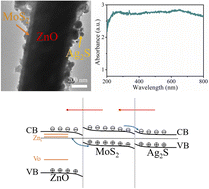Band alignment of ZnO-based nanorod arrays for enhanced visible light photocatalytic performance†
Abstract
A ternary semiconductor ZnO/MoS2/Ag2S nanorod array in an intimate core–shell structure was synthesized on glass substrates. The physicochemical properties and photocatalytical performance of the specimen were characterized and compared with single ZnO and binary ZnO/Ag2S and ZnO/MoS2 nanorod arrays. It is found that the coating layers depressed the band edge emission of the ZnO core, improved light absorption in the visible range, reduced charge transfer resistance, and increased photocatalytic activity. The ternary heterojunction nanorod array possessed full solar absorption with an efficiency of 52.88% for the degradation of methylene blue under visible light in 30 min. The efficiency was higher than other arrays and was 7.6 times that of the ZnO array. Theory analysis revealed that the coating layer brought different band alignment in the heterojunctions for efficient charge separation and conduction, which was beneficial for the photocatalytic performance.



 Please wait while we load your content...
Please wait while we load your content...